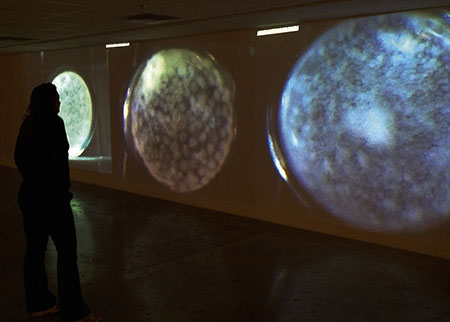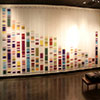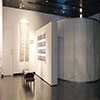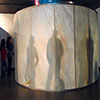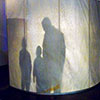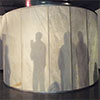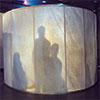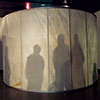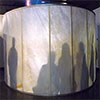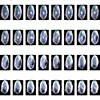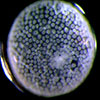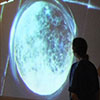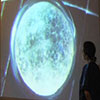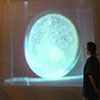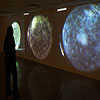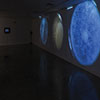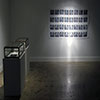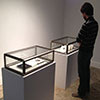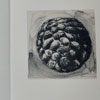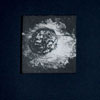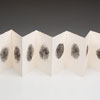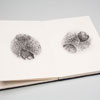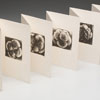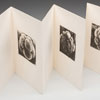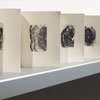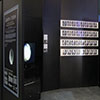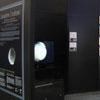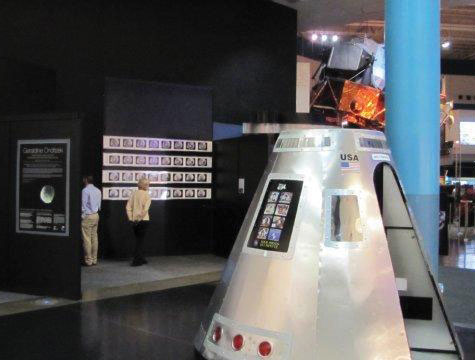Inner Space Global Matters
University of Houston, Clear Lake Art Gallery, The Alfred R. Neumann Library,
NASA, The Johnson Space Center, Houston, Texas
Florida International University, Miami Beach Urban Studios.
With lectures and screenings at, NASA, FIU, Cal Arts, LA, and Hamilton College, New York. 2012-2013
Catalog (pdf)
WORKS IN THE EXHIBITION
CHROMOSOME PAINTING, 2012-13
Lacquered dye and dye sublimation, printed
on Ultra-Sheer® and sheer silk
Panels, 14 x 108 in.
Chromosome Paintings is based on a synteny map, a colorful, striped array that compares gene sequences among species to elucidate the evolution of chromosomes. The technique of chromosome painting, also known as “fluorescence in situ hybridization,” can detect chromosomal markers and abnormalities like translocations and structural alterations associated with various physical qualities and anomalies. For example, chromosome 2 carries a gene for eye color; chromosome 19 carries a gene implicated in leukemia. Each chromosome contains numerous markers contributing to who we are. Original image: Chromosome Painting, Figure 5. Jarllon, Aury, Petit, Thorman. Copyright Clearance, Nature Publishing, 2011
CHROMOSOME LIGHT BOXES 1-22 AND X, 2012
Silk Crepe de Chine, Jacquard dyed and printed.
Edition of 10 of the 24 silk panels 13 x 69 in.
Light Boxes: fir, plexiglass, fiber optic lights
14 x 70 x 3 in.
The silk panels produced in a limited edition of 10 and sold to raise funds for the University of Washington Cancer Genetic Medicine Clinic for those who have cancer and are unable to afford medical diagnosis and treatment.
CELLULAR, 2009-2011 AND SOUND WALL, 2008-2011
Film-10 ft. L x 10 ft. H
Sound Wall-Hand-made abaca paper, aluminum frame
24 ft. around x 8 ft. H
The film Cellular, (12 min. 49 Sec) depicts the early development of a spider embryo, accompanied by the sound of cells as they grow and die. This film was shown inside the Sound Wall installation.
The sound of cells emanates from small speakers embedded in the 24’ wall of handmade paper that curves around the gallery. The sounds are from cells, both healthy and ill, dividing and dying. Bio-physicist Andrew Pelling at UCLA made the recording using an atomic force microscope. To render such minute units audible, the nano-scale vibrations of cells are amplified and brought into the range of human hearing. Pelling found that cells with cancer or other diseases give off low and strained-sounding frequencies while healthy cells produce a more even-toned sound.
CELLULAR FILM STILLS 2009
Archival print, 4’ x 8’ framed in steel and plexiglass
4 rows of film stills depicting gastrulation
Printed in 3 editions
Row 1:
- Early internalization of cells through the blastopore.
- Internalization continues through the blastopore to create an early lower layer.
Row 2:
- Internalization continues through the blastopore; the internalized cells begin to spread out from the center.
- The signaling center, the cumulus, is first apparent and begins its migration towards the prospective dorsal side of the embryo.
- Cumulus migration continues.
- As the cumulus migrates and disperses, an area of cells under its migratory path spreads out to form the “dorsal field”— basically, cells from the body will begin to condense on the side of the cumulus and move away from it.
Row 3:
- The dorsal field continues to expand, changing the area of cells that form the body from a roughly circular shape to an elongated band, and very early segmentation becomes apparent in the anterior body.
- The posterior end of the body begins to form from one end of the germ band and segments are laid down as the growth zone (area with more cells) migrates.
Row 4:
- The posterior body continues to form, and segments become more apparent.
- Segments continue to condense, and legs begin to bud off.
Fertility Prayer Book 1999
Hand drawn images of the blastocyst stage, on cotton rag paper
Bound in black cloth 4” x 3”
Cell Tissue 1999
Hand drawn images of the cell tissue, on cotton rag paper
Bound in black cloth 4” x 3”
Ovum Diving Over and Over 1999
Hand drawn images of the blastocyst dividing, on cotton rag paper
Bound in black cloth 4” x 6”
Ovum 1999
Lithograph on mulberry paper, 7” x 8” closed, 8’ long when open.
This thirteen-print series documents the development of the ovum through the blastocyst stage, in each cell is identified as a particular part of the human anatomy.
The original cells were magnified 900 times with an electron microscope. The images were scanned, enlarged, and altered on a computer, then transferred on to lithograph plates.
CURATOR’S STATEMENT
Geraldine Ondrizek engages diverse artistic media to portray, explore and enhance images of the genetic testing of human and animal cellular tissue as reproduced by geneticists and biologists. An exhibition of her work titled Inner Space, Global Matter: Recording from the Structures Within | Geraldine Ondrizek – Works from 2008 through 2012 opens with a reception and panel discussion on Monday, Nov. 19, 5–7 p.m. The show is on view through Feb. 1, 2013, in the gallery housed in the university's Bayou Building, 2700 Bay Area Blvd., Houston. There will also be a contemporary dance performance in response to the exhibition on Wednesday, Jan. 23, at 6 p.m. in the gallery.
Ondrizek's exhibition is part of a larger collaboration between three institutions. A special presentation of her signature work entitled Cellular, incorporating the video and sound of actual cells dividing, is exhibiting simultaneously at Space Center Houston, University of Houston-Clear Lake Art Gallery, and Florida International University's Miami Beach Urban Studios. Ondrizek's Chromosome Painting, an aesthetic rendering of a synteny map, is also on display at the UHCL Art Gallery. The continuation of this colorful expression of genomic sequencing on silk panels is shown in the Special Collections Room of the UHCL Alfred R. Neumann Library.
The showcasing of Ondrizek's expression of microbial life in NASA's historic communities of Texas and Florida proposes important questions about art and science, comprising the curatorial objective for discussion in the opening reception/panel event and for the published exhibition catalogue, which features an essay by the exhibition's curator Jane Chin Davidson, Assistant Professor of Art History at UHCL. Ondrizek is a Professor of Art at Reed College in Portland, Oregon.
In conjunction with the Nov. 19 opening reception, Ondrizek will join experts from various disciplines to talk about the context of her work in the panel "Intersections of Art, Science & Technology." The artist joins Amy Lampazzi, a mathematics lecturer at UHCL; Darrin Leleux, an engineer at NASA's Johnson Space Center; and Lory Z. Santiago-Vázquez, a biology professor at UHCL. The discussion will be moderated by Davidson. The Jan. 23 dance production will feature the talents of Dominic Walsh Dance Theater. Specially choreographed by Dominic Walsh in response to the works featured in the exhibition, the performance adds yet another layer of interdisciplinarity to the entire project.
